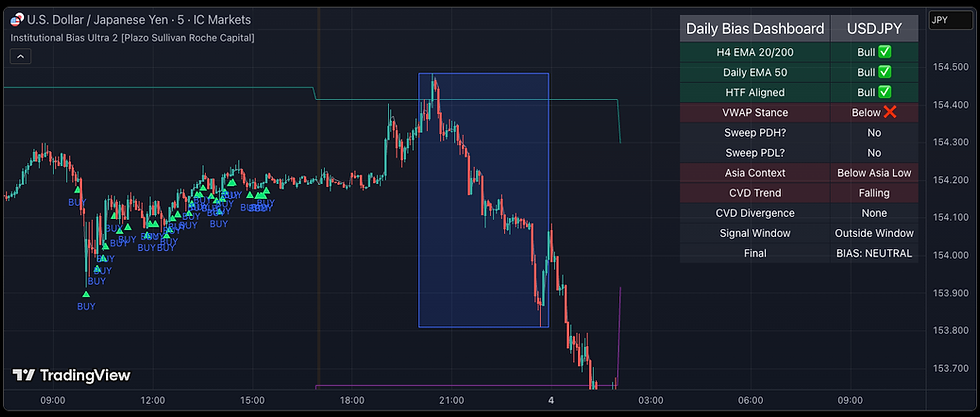The Holy Grail
- Sandra Wakefield

- 2 hours ago
- 4 min read
Holy Grail | Plazo Sullivan Roche Capital
If you saw this chart, would you know where to place your entries? If you said NO, you are ignorant of the one most powerful trading method that beats ICT, SMC, Goldbach and naked price action.

This aforementioned chart combines only information you need to identify entry points and exits. That tale is told by the Visible Range Volume Profile, the Session Volume Profile, and the Cumulative Volume Delta.
During the Pandemic we coded an algorithm that is now a fully autonomous machine learning system that uses all three components to identify sniper points on every chart time frame. It works so well because it highlights where institutions are truly positioned.
Dubbed the Holy Grail, the algorithm uses Volume Profile, Session Volume Profile, CVD, VWAP and a host of fund-grade protections to identify potential positions. The following image shows light from the darkness:

Our early tradingview module does all the calculations and tells you where to buy and sell based on this data:
Regardless of macro trend, the Holy Grail almost never loses. Here’s why.
This tool fuses Visible Range Volume Profile (VRVP), Session Volume Profile (SVP), and Cumulative Volume Delta (CVD) to detect high-probability long/short entries based on institutional-grade confluence.
VRVP (Composite Profile)
Calculates the Volume Point of Control (POC), Value Area High (VAH), and Value Area Low (VAL) from all visible bars on the chart.
Identifies Low Volume Nodes (LVNs) — price zones institutions often defend or reverse from.
SVP (Session Profile)
Dynamically builds intraday profiles within your chosen trading session (e.g., 09:30–16:00 NY).
Updates POC/VAH/VAL in real time as new candles print.
Resets each day (or 24h cycle if 24x7 is enabled).
CVD (Cumulative Volume Delta)
Acts as a buy/sell pressure filter by tracking whether volume is dominated by buyers or sellers within each session.
Optional filter ensures trades align with real market aggression (e.g., only long if CVD slope > 0).
Confluence Detection
Entries trigger only when price interacts with session or composite anchors (POC, VAL, VAH, LVN) depending on your chosen Confluence Requirement.
Strong setups occur when multiple anchors cluster closely (VAL ≈ LVN ≈ VWAP).
Trade Confirmation
Optional reversal candlestick filter confirms market intent:
Bullish/Bearish Engulfing
Hammer / Shooting Star
VWAP alignment ensures institutional mean-reversion bias.
Automatic TP / SL Management
TP1: 50% distance to target anchor (half profit)
TP2: Full target (nearest POC or VA zone)
SL: Below LVN or VAL for longs, above LVN or VAH for shorts
Auto Breakeven: Stop moves to entry after TP1 hit
Trail LVN (optional): For trending markets, BE line trails nearest LVN
🛡️ Protection Mechanisms
Each trade passes through institutional-grade safety layers:
These layers minimize false positives, overtrading, and session bleed, producing only structural, high-quality setups.
Best Practices for Use
Start on Higher Timeframes (HTF)
Use 1H or 90M charts to locate bias zones.
Drop to 15M–5M for entry timing.
Confirm bias with HTF EMA trend (green = bullish, red = bearish).
Look for Confluence Clusters
Strong setups happen where Session VAL ≈ Composite LVN ≈ VWAP or Session VAH ≈ Composite POC.
Use the on-chart labels (“LONG” or “SHORT”) only when filters align.
Combine with Smart Money Concepts (SMC)
Favor entries at liquidity sweeps or order block retests overlapping with VAL/VAH zones.
Session Focus
For BTC/USD: use 08:30–11:30 and 13:00–15:00 (NY) — high-volume periods.
For Forex/Gold: adjust to London or NY session overlap.
Risk Management
Never risk >1–2% per trade.
Always respect automatic SL and allow TP1/TP2 automation to play out.
Disable “Confluence Requirement” only for testing — it’ll show raw filter signals, not institutional-grade entries.
Tutorial: Understanding the Components
1. Visible Range Volume Profile (VRVP)
Found on the right-hand margin of the chart.
Highlights where the majority of volume traded in your visible window.
POC = strongest interest zone (magnet for price).
VAH/VAL = 70% of traded volume zone; outside this area are breakout/fade zones.
LVN = low volume zone → “void” → often fills then reverses.
Trading Tip:
Fade price reactions near LVNs in range conditions.
Breakouts through VAH/VAL with CVD support = strong continuation signals.
2. Session Volume Profile (SVP)
Resets daily or per session.
Reveals intraday accumulation/distribution.
Compare Session POC vs Composite POC:
Above Composite POC = bullish control.
Below Composite POC = bearish control.
Trading Tip:
Favor longs when price reclaims session VAL and CVD flips positive.
Favor shorts when price rejects VAH and CVD flips negative.
3. Cumulative Volume Delta (CVD)
Tracks buying/selling aggression over time.
Rising CVD = buyers lifting offers.
Falling CVD = sellers hitting bids.
Trading Tip:
Use as a confirmation filter.
Enter longs only if CVD slope > threshold (positive slope).
Avoid fading strong CVD trends.
Example Workflow
Open BTCUSD on 5M or 15M chart.
Set Session = 09:30–16:00, enable Kill-Zone Filter.
Observe Session VAL / Composite LVN / VWAP — look for overlap.
Wait for a bullish reversal candle at that overlap.
If “LONG” label prints → trade triggers.
TP1 hits → half position auto-closes, stop moves to breakeven.
TP2 or trail logic finishes the move.
Summary
VRVP + SVP Confluence Entries transforms volume structure into executable trade signals by aligning:
Macro context (Composite Volume)
Micro context (Session Volume)
Market pressure (CVD)
Candle psychology (Reversals)
When used correctly, it acts as an institutional confluence detector that isolates the smart money footprints hidden within the noise.
The Future
Holy Grail consistently outperforms every indicator, module or AI we’ve built based on SMC, ICT, Goldbach, or price action.
A freeware public release of the indicator will be made available 2026. It will not have all the bells and whistles of our fully autonomous systems, but it will be hedgefund grade.



Comments